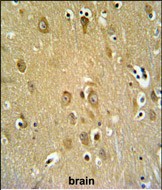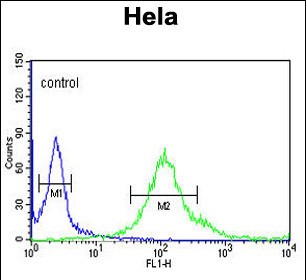SYTL2 Antibody (Center)
Affinity Purified Rabbit Polyclonal Antibody (Pab)
- SPECIFICATION
- CITATIONS
- PROTOCOLS
- BACKGROUND

Application
| FC, IHC-P, WB, E |
|---|---|
| Primary Accession | Q9HCH5 |
| Reactivity | Human |
| Host | Rabbit |
| Clonality | Polyclonal |
| Isotype | Rabbit IgG |
| Calculated MW | 104930 Da |
| Antigen Region | 840-868 aa |
| Gene ID | 54843 |
|---|---|
| Other Names | Synaptotagmin-like protein 2, Breast cancer-associated antigen SGA-72M, Exophilin-4, SYTL2, KIAA1597, SGA72M, SLP2, SLP2A |
| Target/Specificity | This SYTL2 antibody is generated from rabbits immunized with a KLH conjugated synthetic peptide between 840-868 amino acids from the Central region of human SYTL2. |
| Dilution | FC~~1:10~50 IHC-P~~1:50~100 WB~~1:1000 E~~Use at an assay dependent concentration. |
| Format | Purified polyclonal antibody supplied in PBS with 0.09% (W/V) sodium azide. This antibody is purified through a protein A column, followed by peptide affinity purification. |
| Storage | Maintain refrigerated at 2-8°C for up to 2 weeks. For long term storage store at -20°C in small aliquots to prevent freeze-thaw cycles. |
| Precautions | SYTL2 Antibody (Center) is for research use only and not for use in diagnostic or therapeutic procedures. |
| Name | SYTL2 |
|---|---|
| Synonyms | KIAA1597, SGA72M, SLP2, SLP2A |
| Function | Isoform 1 acts as a RAB27A effector protein and plays a role in cytotoxic granule exocytosis in lymphocytes. It is required for cytotoxic granule docking at the immunologic synapse. Isoform 4 binds phosphatidylserine (PS) and phosphatidylinositol-4,5-bisphosphate (PIP2) and promotes the recruitment of glucagon-containing granules to the cell membrane in pancreatic alpha cells. Binding to PS is inhibited by Ca(2+) while binding to PIP2 is Ca(2+) insensitive. |
| Cellular Location | [Isoform 1]: Cytoplasm. Cell membrane Note=Recruited on vesicular structures in cytotoxic T-lymphocytes (CTL) by RAB27A. |
| Tissue Location | Isoform 1 is expressed in hematopoietic lineages with a strong expression in CD4 and CD8 T-lymphocytes. It is also widely expressed in nonhematopoietic tissues. Isoform 5 is expressed only in nonhematopoietic tissues. Isoform 4 is expressed in pancreatic alpha cells. |

Thousands of laboratories across the world have published research that depended on the performance of antibodies from Abcepta to advance their research. Check out links to articles that cite our products in major peer-reviewed journals, organized by research category.
info@abcepta.com, and receive a free "I Love Antibodies" mug.
Provided below are standard protocols that you may find useful for product applications.
Background
SYTL2 is a synaptotagmin-like protein (SLP) that belongs to a C2 domain-containing protein family. The SLP homology domain (SHD) of this protein has been shown to specifically bind the GTP-bound form of Ras-related protein Rab-27A (RAB27A). This protein plays a role in RAB27A-dependent vesicle trafficking and controls melanosome distribution in the cell periphery.
References
Menasche, G., et al. Blood 112(13):5052-5062(2008)
Kesari, A., et al. Am. J. Pathol. 173(5):1476-1487(2008)
Chavas, L.M., et al. Structure 16(10):1468-1477(2008)
If you have used an Abcepta product and would like to share how it has performed, please click on the "Submit Review" button and provide the requested information. Our staff will examine and post your review and contact you if needed.
If you have any additional inquiries please email technical services at tech@abcepta.com.













 Foundational characteristics of cancer include proliferation, angiogenesis, migration, evasion of apoptosis, and cellular immortality. Find key markers for these cellular processes and antibodies to detect them.
Foundational characteristics of cancer include proliferation, angiogenesis, migration, evasion of apoptosis, and cellular immortality. Find key markers for these cellular processes and antibodies to detect them. The SUMOplot™ Analysis Program predicts and scores sumoylation sites in your protein. SUMOylation is a post-translational modification involved in various cellular processes, such as nuclear-cytosolic transport, transcriptional regulation, apoptosis, protein stability, response to stress, and progression through the cell cycle.
The SUMOplot™ Analysis Program predicts and scores sumoylation sites in your protein. SUMOylation is a post-translational modification involved in various cellular processes, such as nuclear-cytosolic transport, transcriptional regulation, apoptosis, protein stability, response to stress, and progression through the cell cycle. The Autophagy Receptor Motif Plotter predicts and scores autophagy receptor binding sites in your protein. Identifying proteins connected to this pathway is critical to understanding the role of autophagy in physiological as well as pathological processes such as development, differentiation, neurodegenerative diseases, stress, infection, and cancer.
The Autophagy Receptor Motif Plotter predicts and scores autophagy receptor binding sites in your protein. Identifying proteins connected to this pathway is critical to understanding the role of autophagy in physiological as well as pathological processes such as development, differentiation, neurodegenerative diseases, stress, infection, and cancer.




